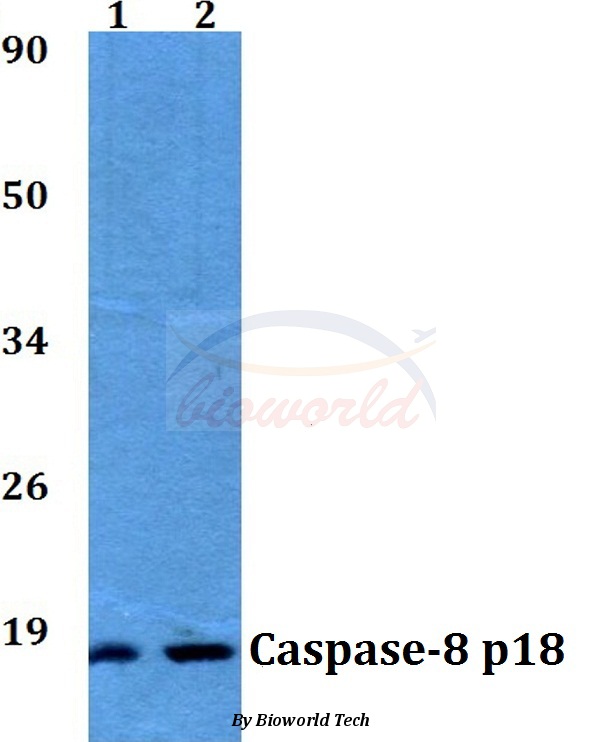Product Name :
Caspase-8 (T341) polyclonal antibody Background :
Caspases are cysteine proteases, expressed as inactive precursors, that mediate apoptosis by proteolysis of specific substrates. Caspases have the ability to cleave after aspartic acid residues. There are two classes of caspases involved in apoptosis; initiators (activation by receptor cluster) and effectors (activation by mitochondrial permeability transition). Proapoptotic signals autocatalytically activate initiator caspases, such as Caspase 8 and Caspase 9. Activated initiator caspases then process effector caspases, such as Caspase 3 and Caspase 7, which in turn cause cell collapse. Product :
Rabbit IgG, 1mg/ml in PBS with 0.02% sodium azide, 50% glycerol, pH7.2 Storage&Stability :
Store at 4°C short term. Aliquot and store at -20°C long term. Avoid freeze-thaw cycles. Specificity :
Caspase 8 (T341) polyclonal antibody detects endogenous levels of full length caspase-8, the cleaved intermediate p43/p41 and the caspase-8 active fragment p18. Immunogen :
Synthetic peptide, corresponding to amino acids 310-362 of Human Caspase-8. Conjugate :
Unconjugated Modification :
Unmodification
Caspase-8 (T341) polyclonal antibody Background :
Caspases are cysteine proteases, expressed as inactive precursors, that mediate apoptosis by proteolysis of specific substrates. Caspases have the ability to cleave after aspartic acid residues. There are two classes of caspases involved in apoptosis; initiators (activation by receptor cluster) and effectors (activation by mitochondrial permeability transition). Proapoptotic signals autocatalytically activate initiator caspases, such as Caspase 8 and Caspase 9. Activated initiator caspases then process effector caspases, such as Caspase 3 and Caspase 7, which in turn cause cell collapse. Product :
Rabbit IgG, 1mg/ml in PBS with 0.02% sodium azide, 50% glycerol, pH7.2 Storage&Stability :
Store at 4°C short term. Aliquot and store at -20°C long term. Avoid freeze-thaw cycles. Specificity :
Caspase 8 (T341) polyclonal antibody detects endogenous levels of full length caspase-8, the cleaved intermediate p43/p41 and the caspase-8 active fragment p18. Immunogen :
Synthetic peptide, corresponding to amino acids 310-362 of Human Caspase-8. Conjugate :
Unconjugated Modification :
Unmodification
-
 Western blot (WB) analysis of Caspase-8 (T341) polyclonal antibody at 1:500 dilution Lane1:sp2/0 cell lysate treated with colchicine(0.2ng/ml,15mins) Lane2:H9C2 cell lysate with colchicine(0.2ng/ml,15mins)
Western blot (WB) analysis of Caspase-8 (T341) polyclonal antibody at 1:500 dilution Lane1:sp2/0 cell lysate treated with colchicine(0.2ng/ml,15mins) Lane2:H9C2 cell lysate with colchicine(0.2ng/ml,15mins) -
 Western blot (WB) analysis of Caspase 8 (T341) pAb at 1:500 dilution Lane1:HEK293T whole cell lysate(40ug) Lane2:HEK293T treated with Etoposide for 5min whole cell lysate(40ug) Lane3:HEK293T treated with Etoposide for 2h whole cell lysate(40ug) Lane4:HEK293T treated with Etoposide for 24h whole cell lysate(40ug)
Western blot (WB) analysis of Caspase 8 (T341) pAb at 1:500 dilution Lane1:HEK293T whole cell lysate(40ug) Lane2:HEK293T treated with Etoposide for 5min whole cell lysate(40ug) Lane3:HEK293T treated with Etoposide for 2h whole cell lysate(40ug) Lane4:HEK293T treated with Etoposide for 24h whole cell lysate(40ug)
Anti-tumor activity and the mechanism of SIP-S: A sulfated polysaccharide with anti-metastatic effect
PMCID: Pubmed No.:26050887
TRAIL and doxorubicin combination enhances anti-glioblastoma effect based on passive tumor targeting of liposomes
PMCID: Pubmed No.:21609741
PEG-liposomal oxaliplatin induces apoptosis in hunman colorectal cancer cells via Fas/FasL and caspase-8.
PMCID: Pubmed No.:21888623
Combination of TRAIL and actinomycin D liposomes enhances antitumor effect in non-small cell lung cancer
PMCID: Pubmed No.:22619505
Down regulation of differentiated embryonic chondrocytes 1 (DEC1) is involved in 8-methoxypsoralen-induced apoptosis in HepG2 cells
PMCID: Pubmed No.:22796345
Salinomycin induces apoptosis in cisplatin-resistant colorectal cancer cells by accumulation of reactive oxygen species
PMCID: Pubmed No.:23916687
Fluoride‐induced apoptosis and expressions of caspase proteins in the kidney of carp (Cyprinus carpio)
PMCID: Pubmed No.:24459041
Norisoboldine induces apoptosis of fibroblast-like synoviocytes from adjuvant-induced arthritis rats
PMCID: Pubmed No.:24613208
Hyperbaric Oxygen Suppresses Hypoxic-Ischemic Brain Damage in Newborn Rats
PMCID: Pubmed No.:24762865
Anacardic acid induces cell apoptosis associated with induction of ATF4-dependent endoplasmic reticulum stress
PMCID: Pubmed No.:24853302
Isolation and antitumor efficacy evaluation of a polysaccharide from Nostoc commune Vauch.
PMCID: Pubmed No.:26201366
Anti-tumor activity and the mechanism of SIP-S, a sulfated polysaccharide with anti-metastatic effect
PMCID: Pubmed No.:26050887
TPX2 Level Correlates with Hepatocellular Carcinoma Cell Proliferation, Apoptosis, and EMT
PMCID: Pubmed No.:26025609
Inhibitory effect of epirubicin-loaded lipid microbubbles with conjugated anti-ABCG2 antibody combined with therapeutic ultrasound on multiple myeloma cancer stem cells.
PMCID: Pubmed No.:26204324
Gambogic acid enhances the radiosensitivity of human esophageal cancer cells by inducing reactive oxygen species via targeting Akt/mTOR pathway
PMCID: Pubmed No.:26318432
Chamaejasmin B exerts anti-MDR effect in vitro and in vivo via initiating mitochondria-dependant intrinsic apoptosis pathway
PMCID: Pubmed No.:26445529
PFR peptide, one of the antimicrobial peptides identified from the derivatives of lactoferrin, induces necrosis in leukemia cells
PMCID: Pubmed No.:26860588
Chamaejasmin B exerts anti-MDR effect in vitro and in vivo via initiating mitochondria-dependant intrinsic apoptosis pathway
PMCID: Pubmed No.:26445529
PFR peptide, one of the antimicrobial peptides identified from the derivatives of lactoferrin, induces necrosis in leukemia cells
PMCID: Pubmed No.:26860588
Hyperbaric Oxygen Suppresses Hypoxic-Ischemic Brain Damage in Newborn Rats
PMCID: Pubmed No.:24762865
Fluoride‐induced apoptosis and expressions of caspase proteins in the kidney of carp (Cyprinus carpio)
PMCID: Pubmed No.:24459041
Norisoboldine induces apoptosis of fibroblast-like synoviocytes from adjuvant-induced arthritis rats
PMCID: Pubmed No.:24613208
Enhancing the anti-multiple myeloma efficiency in a cancer stem cell xenograft model by conjugating the ABCG2 antibody with microbubbles for a targeted delivery of ultrasound mediated epirubicin
PMCID: Pubmed No.:28232025
MiR-320a effectively suppresses lung adenocarcinoma cell proliferation and metastasis by regulating STAT3 signals
PMCID: Pubmed No.:28106481
TRAF2 is a Valuable Prognostic Biomarker in Patients with Prostate Cancer
PMCID: Pubmed No.:28855498
Combined therapeutic effects of bortezomib and anacardic acid on multiple myeloma cells via activation of the endoplasmic reticulum stress response
PMCID: Pubmed No.:27430733
Fruiting body polysaccharides of Hericium erinaceus induce apoptosis in human colorectal cancer cells via ROS generation mediating caspase-9-dependent signaling pathways
PMCID: Pubmed No.:32573644
Mycobacterium tuberculosis PPE10 (Rv0442c) alters host cell apoptosis and cytokine profile via linear ubiquitin chain assembly complex HOIP-NF-κB signaling axis
PMCID: Pubmed No.:33667868
Synergistic antitumour effects of triptolide plus 10-hydroxycamptothecin onbladder cancer
PMCID: Pubmed No.:31063955
Sodium tanshinone IIA sulfonate protects ARPE-19 cells against oxidative stress by inhibiting autophagy and apoptosis
PMCID: Pubmed No.:30310136
Nuclear respiratory factor 1 protects H9C2 cells against hypoxia-induced apoptosis via the death receptor pathway and mitochondrial pathway
PMCID: Pubmed No.:33913583
Epidermal growth factor‐containing fibulin‐like extracellular matrix protein 1 (EFEMP1) suppressed the growth of hepatocellular carcinoma cells by promoting Semaphorin 3B(SEMA3B)
PMCID: Pubmed No.:30972979
Overexpression of HACE1 in gastric cancer inhibits tumor aggressiveness by impeding cell proliferation and migration
PMCID: Pubmed No.:29673126
Polysaccharides from Nostoc commune Vaucher activate macrophages via NF-κB and AKT/JNK1/2 pathways to suppress colorectal cancer growth in vivo
PMCID: Pubmed No.:31259992
Diterpene pekinenal from euphorbia pekinensis radix induced IEC-6 cells apoptosis mediated by mitochondria and death receptors
PMCID: Pubmed No.:30710624
Synergistic suppression effect on tumor growth of acute myeloid leukemia by combining cytarabine with an engineered oncolytic vaccinia virus
PMCID: Pubmed No.:30410347
Bioworld Biotech only provide peptides for our antibodies and do not provide additional peptide customization services.
Price/Size :
USD 368/1mg/vial
Tips:
For phospho antibody, we provide phospho peptide(0.5mg) and non-phospho peptide(0.5mg).Describe :
Blocking peptides are peptides that bind specifically to the target antibody and block antibody binding. These peptide usually contains the epitope recognized by the antibody. Antibodies bound to the blocking peptide no longer bind to the epitope on the target protein. This mechanism is useful when non-specific binding is an issue, for example, in Western blotting (WB) and Immunohistochemistry (IHC). By comparing the staining from the blocked antibody versus the antibody alone, one can see which staining is specific; Specific binding will be absent from the western blot or IHC performed with the neutralized antibody.Formula:
Synthetic peptide was lyophilized with 100% acetonitrile and is supplied as a powder. Reconstitute with 0.1 ml DI water for a final concentration of 10 mg/ml.The purity is >90%,tested by HPLC and MS.
Storage:
The freeze-dried powder is more stable. For short time at 2-8°C. For long term storage store at -20°C.
Note :
This product is for research use only (RUO only). Not for use in diagnostic or therapeutic procedures.
 Caspase-8 (T341) polyclonal antibody
Caspase-8 (T341) polyclonal antibody  Datasheet
Datasheet COA
COA MSDS
MSDS SHIP
SHIP